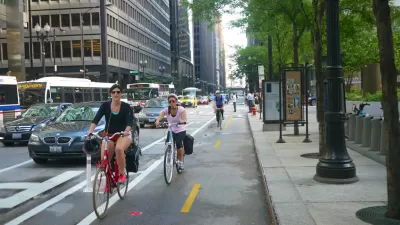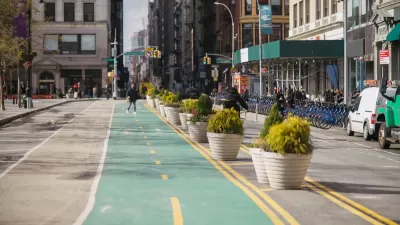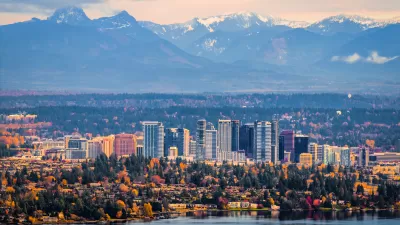Montreal city planners used a simple tactic to illustrate the small portion of area car parking that would need to be foregone in order to build a downtown bike path.

Every city that's ever considered removing auto parking to make room for a protected bike lane has been, understandably, nervous. North America's best city for biking wasn't immune.
But when it was planning its signature downtown bike project in 2005, Montreal got past those concerns with a very simple tactic. Instead of counting only the change in parking spaces on the boulevard De Maisonneuve itself, a measure that might have led to headlines and perceptions that "half of the parking" was being removed, it counted the total number of auto parking spaces — public and private, on-street and off — within 200 meters of the project.
The district, it turned out, had 11,000 parking spaces. Converting one of the corridor's two auto parking lanes to a protected bikeway would remove 300 of them, or just under 3 percent.
"The effect on the debate was suprise," said Jean-Francois Pronovost of Vélo Québec, the bike advocacy and planning nonprofit contracted by the city to study the issue. "No one estimated that there was that number of car parking [spaces] available."

FULL STORY: HOW MONTREAL BUILT A BIKE LANE BY DEBUNKING THE AUTOPARKOLYPSE

Alabama: Trump Terminates Settlements for Black Communities Harmed By Raw Sewage
Trump deemed the landmark civil rights agreement “illegal DEI and environmental justice policy.”

Planetizen Federal Action Tracker
A weekly monitor of how Trump’s orders and actions are impacting planners and planning in America.

The 120 Year Old Tiny Home Villages That Sheltered San Francisco’s Earthquake Refugees
More than a century ago, San Francisco mobilized to house thousands of residents displaced by the 1906 earthquake. Could their strategy offer a model for the present?

LA’s Tree Emergency Goes Beyond Vandalism
After a vandal destroyed dozens of downtown LA trees, Mayor Karen Bass vowed to replace them. Days later, she slashed the city’s tree budget.

Sacramento Leads Nation With Bus-Mounted Bike Lane Enforcement Cameras
The city is the first to use its bus-mounted traffic enforcement system to cite drivers who park or drive in bike lanes.

Seattle Voters Approve Social Housing Referendum
Voters approved a corporate tax to fund the city’s housing authority despite an opposition campaign funded by Amazon and Microsoft.
Urban Design for Planners 1: Software Tools
This six-course series explores essential urban design concepts using open source software and equips planners with the tools they need to participate fully in the urban design process.
Planning for Universal Design
Learn the tools for implementing Universal Design in planning regulations.
Ada County Highway District
Clanton & Associates, Inc.
Jessamine County Fiscal Court
Institute for Housing and Urban Development Studies (IHS)
City of Grandview
Harvard GSD Executive Education
Toledo-Lucas County Plan Commissions
Salt Lake City
NYU Wagner Graduate School of Public Service





























